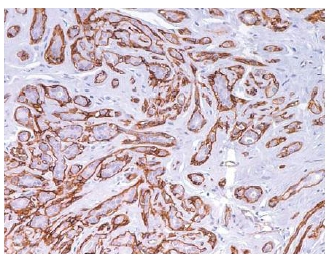p75 NGF Receptor (NGFR) Mouse Monoclonal Antibody [Clone ID: MRQ-21]
CAT#: AM10123SU-N
p75 NGF Receptor (NGFR) mouse monoclonal antibody, clone MRQ-21, Supernatant
Other products for "NEFL"
Specifications
| Product Data | |
| Clone Name | MRQ-21 |
| Applications | IHC |
| Recommended Dilution | Immunohistochemistry on Formalin-Fixed, Paraffin-Embedded Sections: 1/50-1/200 Pretreatment of deperaffinized tissue with heat-induced epitope retrieval is recommended. Use Polymer anti Mouse/Rabbit IgG as a detection system. Positive Control: Breast tissue. |
| Reactivities | Human |
| Host | Mouse |
| Isotype | IgG1 |
| Clonality | Monoclonal |
| Immunogen | Purified Human NGFR protein. |
| Specificity | Recognizes CD271 / NGFR. Cellular Localization: Cytoplasmic. |
| Formulation | State: Supernatant State: Liquid Tissue Culture Supernatant with 0.2% BSA and 15mM Sodium Azide. |
| Storage | Store the antibody undiluted at 2-8°C. |
| Stability | Shelf life: one year from despatch. |
| Gene Name | Homo sapiens neurofilament, light polypeptide (NEFL) |
| Database Link | |
| Background | NGFR, a 75 kd glycoprotein (also known as P-75NTR), is the first of neurotrophin receptors to be isolated and is a member of the tumor necrosis factor (TNF) receptor family. It is expressed not only in sympathetic and sensory neurons, but also in various neural crest cell or tumor derivatives such as melanocytes, melanomas, neuroblastomas, pheochromocytomas, neurofibromas, and neurotized nevi (type C melanocytes). NGFR has been shown to be a reliable marker for desmoplastic and neurotropic melanoma by several groups. It is now apparent that expression of NGFR is ubiquitous and not limited to the nervous system, being expressed in mature nonneural cells such as perivascular cells, follicular dendritic cells, basal epithelium of oral mucosa and hair follicles, prostate basal cells and myoepithelial cells. Studies in prostate and urothelial cancer suggest that NGFR may act as a tumour suppressor, negatively regulating cell growth and proliferation. Anti-NGFR labels the myoepithelial cells of breast ducts and intralobular fibroblasts of breast ducts and thus aides in the diagnosis of malignancy in the breast. |
| Synonyms | TNFRSF16 |
| Reference Data | |
| Protein Families | Druggable Genome, ES Cell Differentiation/IPS |
| Protein Pathways | Amyotrophic lateral sclerosis (ALS) |
Documents
| Product Manuals |
| FAQs |
{0} Product Review(s)
0 Product Review(s)
Submit review
Be the first one to submit a review
Product Citations
*Delivery time may vary from web posted schedule. Occasional delays may occur due to unforeseen
complexities in the preparation of your product. International customers may expect an additional 1-2 weeks
in shipping.






























































































































































































































































 Germany
Germany
 Japan
Japan
 United Kingdom
United Kingdom
 China
China



